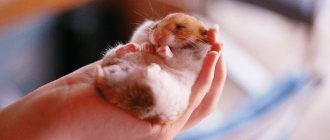Having noticed a tumor in a hamster, owners are often perplexed - what happened to their pet, where did this attack come from in a healthy, active animal. Few people realize that it could be cancer. Tumors almost never occur in hamsters under the age of one year, but among animals older than 2 years, oncology is very widespread.
A tumor is not always oncology
The diagnosis must be made by a qualified specialist in a veterinary clinic, but not everyone has the opportunity to get an appointment with a veterinarian. A preliminary conclusion can be made based on the localization of the formation:
- if the hamster has a lump on its neck, it may be an inflammation of the lymph node;
- a tumor on the abdomen in most cases is a neoplasm of the mammary gland;
- swelling of the cheek and swelling of the muzzle suggest a problem with the teeth or cheek pouches;
- swelling on the head, forehead or back may be the result of a hamster fight or other injury.
When examining the animal, you should remember the location of the marker glands in males, which are often mistaken for a sore.
In the Djungarian hamster it is located on the stomach, yellowish and covered with crusts. The Syrian hamster has two of them, symmetrically on the sides, in front of the hind legs. They look like a black oval bald spot. This is a normal anatomical formation, and there is nothing to treat here, but observation will not be superfluous: inflammation or neoplasm of the scent gland is often recorded in hamsters.
Growths in the ear are also not always a malignant tumor. In hamsters, otitis media (inflammation) of the middle ear can be accompanied by cyst-like tissue growth. In this case, the growths are filled with pus, and an unpleasant odor comes from the ears. Treatment is antibiotics locally and systemically, but otitis media often recurs again and again without being completely cured.
Hamsters can suffer from papillomatosis , a viral infection that causes the formation of dense warts of a characteristic appearance on the skin due to the accelerated growth of the epithelium.
Papilloma rarely has to be removed surgically: it is a benign formation, and when the body copes with the virus, self-healing may occur.
Treatment
To carry out the correct treatment, you need to pay attention to the condition of the tumor. If the area is not very red or swollen, then most likely surgery will not be required. If we are talking only about the inflammatory process, then it is best to prescribe a course of antibiotics or drugs that block tumor growth. If you take the medications on schedule, the abscess will not develop.
If the tumor has become too large, then you need to go to a hospital. In the hospital they must clean the wound and treat it with special compounds. Sometimes it becomes difficult for your pet to move without additional drainage. In such situations, you need to install a special drainage on the baby’s body. It is not possible to make such drainage at home.
If the wound breaks out on its own, then the breakout site should be treated with furatsilin and hydrogen peroxide. Here you don’t have to take your pet to the clinic, but you should definitely consult with a specialist. This is necessary to prevent your pet’s blood from becoming infected. Some infections can be fatal.
Abscess in a hamster
As a result of fights or other injuries, purulent inflammation may occur, which looks like a limited swelling. The lump on the side may well be an abscess rather than cancer. At first it is hard and painful, and the skin is red and hot to the touch. Then the tumor softens and fluctuation appears. Hair may fall out. At the final stage, the abscess spontaneously opens and a wound appears from which pus flows.
For an abscess in a hamster, treatment involves the use of systemic antibiotics (Baytril 2.5% subcutaneously 10 mg/kg body weight). Surgical treatment of the wound is necessary: opening the abscess, cleaning the cavity and washing with an antiseptic. The wound is washed every day and protected from re-infection.
If the abscess is not treated properly, the process becomes chronic and a fistula appears, which will be difficult to heal.
Tumor on a hamster's cheek
A special case of an abscess is inflammation of the cheek pouch, the most likely reason that a hamster has a swollen cheek. Injury occurs from the inside, with a sharp object or unsuitable food: wood chips, dry pasta, seeds and nuts in shell, hay. The wound gets infected and fester occurs.
When your pet's cheek is swollen, it is better not to hesitate to visit a doctor. Purulent inflammation spreads to the surrounding tissues, and next to the cheek there are the most important structures: the eyes, ears and brain. The pain does not allow the baby to eat, and the animal quickly weakens.
If the animal's cheeks are swollen symmetrically, they should be gently massaged towards the muzzle. Then the hamster will reflexively throw out the contents of the cheek pouch, and it will be clear whether there is a problem. If the seal is preserved, the contents are checked by pulling back the edge of the lips with your hand or a stick and at the same time pressing on the cheek under the ear. This must be done while firmly holding the hamster and trying not to damage the mucous membrane.
Sometimes it makes more sense to treat a swollen cheek in a clinic setting under anesthesia. The doctor will be able to completely turn out the cheek pouch, remove foreign objects, rinse with an antiseptic (an aqueous solution of furatsilin, chlorhexidine), open the abscess and empty the cavity of pus.
When a hamster has a bump on its cheek, in addition to the cheek pouches, the doctor must check the animal’s bite.
Rodents' teeth grow throughout their lives and should be worn down normally. If this does not happen, the molars grow excessively - this is called malocclusion.
For dental problems:
- loss of appetite (or complete refusal to eat);
- discharge from the nose or swollen eye;
- abscess on the cheek, swelling.
If the length of the teeth is not adjusted, the hamster will die.
A tumor in a hamster’s neck can also indicate an inflammatory process in the oral cavity - then the nearest, “barrier” lymph node enlarges and looks like a hard lump in the area under the lower jaw. Lymph nodes also enlarge with a systemic infectious disease.
Prevention
Preventive measures cannot fully guarantee protection against cancer and other diseases, but the risk of disease is reduced many times over. To protect your cute animal, follow these rules:
- Clean the cage and wash it often, this will reduce the population of pathogens.
- Do not allow rodents to mate frequently if you have a married couple living with you. Remember that childbirth significantly undermines the body's defenses.
- Do not feed animals fatty foods.
- Take care of your animal's immunity. Fresh herbs and vegetables are great for this purpose.
Following these recommendations will have a good effect on the mood and health of the furry, prevent the occurrence of infectious diseases, and reduce the risk of tumors.
At the first symptoms of the disease, you should not self-medicate, but run to the doctor. Timely diagnosis and therapy will help cope with a number of diseases, but if your furry friend is diagnosed with cancer, you will have to come to terms with it.
What to do if your hamster has a swollen paw
If your pet's paw is swollen, then the first thing to suspect is a closed fracture of the hamster's paw.
An accurate diagnosis can be obtained by taking an x-ray using a good quality digital device. True, this is more of a scientific interest - neither surgery nor a cast will be performed in a veterinary clinic, only complete rest is prescribed.
What to do if your paw is swollen and the cause is unknown:
- Place in a small carrying container with solid walls without rods.
- Use paper towels instead of bedding.
- Dosed, complete feeding, monitor the presence of appetite.
- Examine the animal, checking whether a wound has appeared on its paw. Sometimes, even with open fractures, sticky hair makes it difficult to see the wound. If the animal fought with a relative, or was otherwise injured, the lump on the paw may turn out to be an abscess. Then the abscess sooner or later opens up, and it is treated like an open wound, washed daily with an antiseptic.
In the worst case scenario, the tumor on the paw turns out to be osteosarcoma . This is a malignant oncological disease that progresses rapidly and cannot be cured.
Over time, the paw is no longer visible; the entire limb is a tumor mass that spreads to the body of the animal. Osteosarcoma is more common in older animals (1-2 years).
Habitats and how to arrange a cage. Diseases of Djungarian hamsters
Since some people keep Djungarian hamsters as a pet, their habitat is a cage or a specially equipped terrarium with oxygen supply. Thus, a person can easily track the life cycle of animals. There should be no high structures in cages and terrariums
.
These animals are so agile that they are sometimes clumsy, and this can cause further injury, for example, if they fall from a height. If a hamster falls, it can get bruises or scratches
, which in turn can worsen, leading to more serious consequences. Close observation with due attention to the hamsters will give you the opportunity to promptly notice any deviations from the usual norm.
Let's together highlight some important aspects when arranging the future home of the Djungarian hamster
. The cage should contain a sippy cup, feeders, a house and wheels for games, since these animals, as mentioned earlier, are very mobile. The presence of stairs, tunnels and other household items at your request. Some people arrange the presence of two furious elevations in the cage.
These animals are not very endowed with the instinct of self-preservation by nature; only the close attention of their owners, as well as care for such a cute creature, will help prolong the life of the animal. If you once came up with the idea of getting a Djungarian hamster and you think that you will have no problems coping with such a small creature, then you are mistaken. Before getting an animal, it is worth talking with knowledgeable people who have experience in handling such animals. If you decide to give a gift to a child, then you should give a gentle lecture on handling and care. Any animal in the house is a great responsibility for their owners. The lecture will help you prevent your child from further disappointment.
Why does a hamster have big testicles?
After the male reaches puberty, inexperienced owners begin to sound the alarm, figuring out what to do if the hamster’s testicles are too large. But large testes relative to body size in rodents are a common occurrence. In a Syrian hamster, they become noticeable (a pair of tubercles in the lower abdomen) at the age of 2 months, and after another month the hair on them thins out and you can notice that the testicles have greatly enlarged. Hamsters can have unilateral cryptorchidism - when one testis descends into the scrotum, and the second remains in the abdominal cavity. Then the swelling in the tail area will be one-sided.
Consider the possible reasons why your hamster's testicles are swollen.
Puberty
When the animal is ready to reproduce, seminal fluid accumulates in the testes. Often, a “tumor on the butt” of a young Dzungarian male turns out to be a man’s penis of normal size.
Hormonal disbalance
Most often, when keeping males and females in the same room (but in different cages).
Inflammatory process
Red and hot skin on the testes, signs of pain are signs of infection, orchitis. Treatment is carried out with antibiotics, but not always successfully.
Oncology
There are both benign and malignant testicular tumors (seminoma). Regardless of the type of formation, the only treatment is removal of the affected organ (castration) under general anesthesia. Oncology is characterized by a one-sided lesion, in contrast to orchitis.
Factors that cause compaction
New growths can be small or huge. According to veterinarians, tumors are more likely to occur in female Djungarian hamsters, which is associated with reproductive characteristics. Males of this species and representatives of other breeds suffer less from this disease.
The reasons that contribute to the appearance of compactions are:
- Fractures or bruises.
- Viral infections.
- Wrong diet.
- The presence of an inflammatory process in the body.
- Congenital pathology.
Depending on the reasons for the appearance of tumors, the types of tumors in hamsters will also be different.
Surgical intervention
If a tumor is detected in your pet, you must take a risk and agree to surgical removal. The formations in rodents grow rapidly, the skin cannot withstand it and bursts, forming a fetid, non-healing ulcer. The tumor mass prevents the animal from moving; sometimes the hamsters themselves try to chew off the foreign tissue and die from blood loss. If a limb is affected by cancer, amputation is the best option. If the tumor is on the body, it must be removed while it is still small, otherwise it will be difficult for the surgeon to close the skin defect after removal.
The use of inhalation anesthesia in recent years has increased the survival rate of rodents after surgery. The doctor must have experience working with rodents and ensure that the tiny organism does not become hypothermic during anesthesia. A starvation diet before surgery is not prescribed, and is even harmful.
Removing the tumor itself will not cure the hamster; it will remain sick and may die from tumor metastases to other organs (lungs, liver). But it can improve the quality of life.
If internal organs are affected by cancer, one can only guess about this by the symptoms or asymmetry of the abdomen. In this case, the operation does not make sense and the operation comes down to euthanasia on the surgical table.
Diagnosis of the disease
Fats that tend to grow into blood vessels and deep tissues (infiltrative lipomas) are often confused with cancer, so they must be examined carefully.
To determine the nature of the neoplasm, a biopsy (tissue sampling) is performed. In case of infiltrative compaction, computed tomography (CT) is prescribed to determine the extent of tumor damage to blood vessels and muscles.
Histological analysis
Lipoma consists of lobules of adipose tissue separated by connective tissue septa. If there are few blood vessels, then it is dense and damage does not lead to heavy bleeding.
Any neoplasm on the animal’s body must be examined, since there is a risk of degeneration of a benign tumor into a malignant one (liposarcoma).











